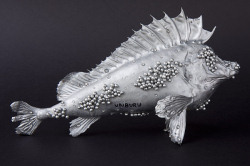A thousand delegates from about 140 nations adopted a treaty Thursday, October 10 in Kumamoto regulating the use and trade of mercury at an international conference organized by the U.N. Environment Program.
Background:
Mercury and mercury compounds have long been known to be toxic to humans and other organisms. In order to prevent global environmental pollution and health damage caused by mercury, a new convention named "Minamata Convention on Mercury" was agreed at the fifth session of the Intergovernmental Negotiating Committee to prepare a global legally binding instrument on mercury (INC5) held in Geneva, Switzerland in January 2013. The treaty's name is related to the large-scale public health crises due to mercury poisoning that was first discovered in Minamata city in Kumamoto prefecture, Japan, in 1956.
The text of the “Minamata Convention on Mercury” was presented for adoption and opened for signature at the Conference of Plenipotentiaries - Diplomatic Conference -, that took place this week at Hotel Nikko in Kumamoto and in Minamata, Japan.

| Sculpture"Pez-Peste"
(Artist: Nicolas Garcia Uriburu)
The sculpture is the symbol for
the Convention and has followed
the committee throughout the
negotiation process
|
Minamata Convention:
The pact, which will take effect 90 days after ratification by 50 nations, maps out measures to curb health and environmental damage caused by mercury, “recognizing the substantial lessons of Minamata disease,” according to a text of the treaty.
“Each party shall not allow, by taking appropriate measures, the manufacture, import or export of mercury-added products” after the phaseout date of 2020, the text says, referring to a list of products, including batteries, switches and relays, compact fluorescent lamps, soaps and cosmetics, thermometers and blood pressure devices and other products, that contain a certain level of mercury.
The treaty also says “each party shall not allow the export of mercury except” for uses specified under the convention.
The treaty will ban mining of fresh mercury and only allow “primary mercury mining that was being conducted within its (party’s) territory at the date of entry into force of the Convention for it for a period of up to 15 years after that date.”
It also seeks to decrease the discharge of mercury into the air, water and land, to promote proper storage and disposal of mercury, as well as reduce the use and discharge of mercury in the process of gold mining in developing countries.
“The people have taken a stand to reduce the risks of mercury to the fullest extent possible,” Environment Minister Nobuteru Ishihara told reporters after the treaty was adopted, and urged all nations to ratify the pact.
The pact, which is expected to take effect in 2016 at the earliest, will also provide financial aid through a fund to developing countries to assist their efforts to cut mercury emissions, but does not refer to issues such as compensation for victims and who should be obliged to restore mercury-contaminated environments.
The Minamata Convention on Mercury is now open for signature by Member States and regional economic integration organizations at the United Nations Headquarters in New York until 9 October 2014.
 Related Information:
Related Information: Ministry of the Environment, Japan: "Lessons from Minamata Disease and Mercury Management in Japan"
Ministry of the Environment, Japan: "Lessons from Minamata Disease and Mercury Management in Japan" UNEP: Reducing Risk from Mercury
UNEP: Reducing Risk from Mercury UNEP: Diplomatic Conference for the Minamata Convention on Mercury
UNEP: Diplomatic Conference for the Minamata Convention on Mercury UNEP: Studies and Reports related to the mercury problem
UNEP: Studies and Reports related to the mercury problem International Institute for Sustainable Development (IISD): Report on the Fifth Session of the Intergovernmental Negotiating Committee to Prepare a Global Legally Binding Instrument on Mercury (INC5)
International Institute for Sustainable Development (IISD): Report on the Fifth Session of the Intergovernmental Negotiating Committee to Prepare a Global Legally Binding Instrument on Mercury (INC5) International POPs Elimination Network (IPEN): Guide to the New Mercury Treaty (PDF)
International POPs Elimination Network (IPEN): Guide to the New Mercury Treaty (PDF) Related EVISA Resources
Related EVISA Resources Link database: Mercury exposure through the diet
Link database: Mercury exposure through the diet Link database: Environmental cycling of mercury
Link database: Environmental cycling of mercury Link database: Toxicity of Organo-mercury compounds
Link database: Toxicity of Organo-mercury compounds Link database: Research projects related to organo-mercury compounds
Link database: Research projects related to organo-mercury compounds Related EVISA News
Related EVISA News January 21, 2013: UNEP mercury treaty exempts vaccines for children
January 21, 2013: UNEP mercury treaty exempts vaccines for children  January 14, 2013: United Nations Global Mercury Treaty: Fifth and final session
January 14, 2013: United Nations Global Mercury Treaty: Fifth and final session  December 18, 2012: Pediatricians Argue to Keep Thimerosal in Some Vaccines
December 18, 2012: Pediatricians Argue to Keep Thimerosal in Some Vaccines
 December
9, 2012: Mercury in fish more dangerous than previously believed;
Scientists urge for effective treaty ahead of UN talks
December
9, 2012: Mercury in fish more dangerous than previously believed;
Scientists urge for effective treaty ahead of UN talks
 October 12, 2012: Prenatal mercury intake linked to ADHD
October 12, 2012: Prenatal mercury intake linked to ADHD July 15, 2012: World Health Organization Fails In Its Effort To Defend Mercury In Vaccines Before United Nations
July 15, 2012: World Health Organization Fails In Its Effort To Defend Mercury In Vaccines Before United Nations
 October 28, 2011: WHO worries mercury treaty could affect costs and availability of vaccines
October 28, 2011: WHO worries mercury treaty could affect costs and availability of vaccines  August 8, 2011: UNEP Global Mercury Treaty May Include Ban on Mercury in Medicine
August 8, 2011: UNEP Global Mercury Treaty May Include Ban on Mercury in Medicine June 19, 2011: Committee for Socio-economic Analysis agrees on
two draft opinions on restriction proposals for mercury compounds under
REACH
June 19, 2011: Committee for Socio-economic Analysis agrees on
two draft opinions on restriction proposals for mercury compounds under
REACH
last time modified: January 18, 2025